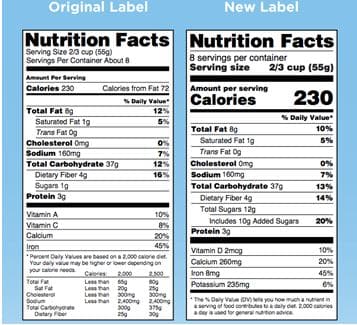How much ADDED sugar is your child getting?
How much do you know about the sugar in the food and drinks your children consume?
Most children in the US consume more sugar than is healthy. On average, 19 teaspoons of sugar are consumed per day, while 5 teaspoons are recommended as a limit.
Research has shown that children who consume too much sugar are at increased risk of cardiovascular disease, dental caries, and unhealthy weight gain.
Foods and drinks can contain naturally occurring sugars as well as added sugars.
Fruits, vegetables and grains all have varying amounts of naturally occurring sugars, but eating these foods has other health benefits, such as giving us vitamins and fiber, that outweigh the sugar content. Also, foods with naturally occurring sugar contain far less sugar compared to processed food with added sugar.
For example, carrots contain sugar; but you would have to eat about 3 pounds of raw carrots to get the same amount of sugar in a 20 ounce bottle of Coca-Cola.
The taste for sweet foods is the earliest one to develop, and it is a powerful influence on the enjoyment of foods. That’s why its added to so many foods, so people will like them and buy more of them.
Even commercially prepared infant and toddler foods (like cereal, fruit snacks, yogurt and flavored milk, not just cookies and desserts,) often contain added sugar.
Okay, so we know that there is too much sugar in many foods available for us to serve to our kids, from the time they start solids, but how do we sort out what is best, better, and not so good?
In August 2016 the American Heart Association published guidelines on sugar consumption for children, which are endorsed by the American Academy of Pediatrics.
Some of these recommendations are as follows:
1-Children over age 2 years should consume no more than 6 teaspoons (25 grams) of added sugar each day.
But what does that exactly mean?
The amount of total sugar in foods is listed on nutritional labels in grams, but this is difficult to translate into a meaningful idea of exactly how much sugar is in there.
To help with this, often gram amounts are “translated” into teaspoons, but even this more familiar measurement is not that helpful.
Some great websites to help you visualize and better understand just how much sugar is in the foods and drinks your children consume are here: http://www.sugarstacks.com
This site has excellent visual examples of comparative amounts of total sugar and added sugar in many different foods: http://www.cdc.gov/healthyweight/healthy_eating/drinks.html
Current nutritional labels in the US do not specify how much added sugar is in our food, just total amount of sugar. US food labels are going to change soon to make it easier to identify added sugar in our food. In July 2018, food labels are scheduled to change to reflect amounts of ADDED sugar, making it easier to identify foods and drinks that have more than you would like your child to consume.
The new labels will look like this:
For now, you should look for the ingredients high fructose corn syrup, honey, sucrose (table sugar), and fructose, especially in the first two or three ingredients. Most of the time, choose foods and drinks that don’t include them to serve to your children.
2-Children should not drink more than one 8-ounce sugar-sweetened beverage PER WEEK.
But what is a “sugar sweetened beverage?” This does not just mean soda. Flavored water, sports drinks, flavored teas, flavored milks (cow, soy, almond, coconut,) can contain nearly or just as much sugar as soda in a realistic, typical serving a child drinks. (usually 12-16 ounces.)
A note about fruit juice: 100% fruit juice contains only naturally occurring sugar and it does contain important vitamins such as vitamin c. However, children often drink far more juice than is needed for health. The AAP recommends no more than 4- 6 ounces a day of 100% juice with no added sugar. That’s about half of an average size cup for a kid. Many parents tell me they “dilute” the juice with water, which is not a bad idea. However when you do this, it is very easy to lose track of how much juice your child is drinking.
So, it is best to give it full strength, but limit the amount per day, and train your children to drink water instead.
3-Children under 2 years should avoid consuming any added sugar since they need nutrient-rich diets and are developing taste preferences
When your baby starts solid foods, you should look closely at the labels of any commercially prepared food you give, and also pay close attention to the amount of any added sugar you put in home made foods. (not just granulated sugar; also honey, agave, molasses, etc.)
Children learning to eat solids should have a side variety of different tastes and textures introduced, even if it appears they “don’t like” them. The taste of sweet foods will almost always be more appealing to most babies, but it is very important to introduce other flavors (bitter, savory, sour). The more exposure to flavors that are not so immediately appealing, the better.
Sweet tasting foods can and should be a part of your child’s diet. We recommend you consider them treats that are to be enjoyed at special times, like holidays and parties. For everyday, follow the guidelines here to help you understand how to set limits on sugar in your child’s diet.
.


